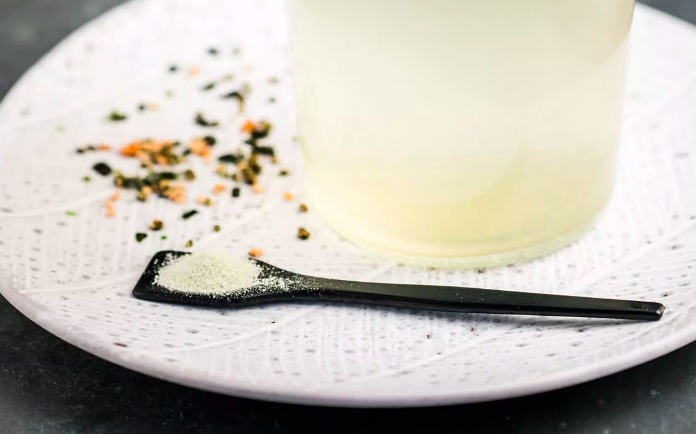Kombucha benefits: Why everyone is talking about this fermented drink


Even those with just a passing interest in wellness trends are likely to have heard of the health drink of the moment, kombucha.
Bottles of the stuff line the shelves of health food shops and, increasingly more often, cafes and supermarkets.
Kombucha may well be one of the big wellness trends in recent months, but the drink dates back over 2,000 years to ancient China. The first recorded use of kombucha comes in 221 BC, when it was known as the 'Tea of Immortality' - and was thought to ward off everything from arthritis to cancer.
So, just what is this wonder drink? Here’s everything you need to know…
What is kombucha?
Kombucha is a fermented drink, made from black or green tea, sugar and a bacteria culture. It’s known for its vinegary smell and slight apple aftertaste.
It’s often one of the recommended fermented foods, along with kefir, kimchi and sauerkraut. Fermented foods are full of probiotics, which are great for your microbiome (the bacteria that live in your body). With the human body containing up to 10 times as many bacterial cells as human cells, it’s worth feeding the beneficial ones.
How is kombucha made?
A starter culture of bacteria, known as a SCOBY (symbiotic culture of bacteria and yeast), is added to the tea and sugar.
Sign up for the woman&home newsletter
Sign up to our free daily email for the latest royal and entertainment news, interesting opinion, expert advice on styling and beauty trends, and no-nonsense guides to the health and wellness questions you want answered.
The mix is then left to ferment at room temperature for 7-10 days. The yeast digests the sugar and emits C02.
Once the bacteria has colonised, it can be scooped off and used again for another brew. The fizzy, sour beverage underneath is ready to drink.
What are kombucha benefits?
Kombucha has a wealth of reported benefits, including improved digestion, less stress and more energy.
Frequent drinkers have used it for ailments such as acne, fatigue, hypertension, headaches, constipation.Some experts believe kombucha to be a good source of B vitamins, which regulate metabolism.
Most of the health boosts are anecdotal, but initial scientific research on rats has shown kombucha to reduce DNA damage and the effects of stress on the immune system.
Where does kombucha come from?
No-one is quite sure of Kombucha’s exact origins, but it’s believed to have come from China. It has also been used in Eastern Europe, Russia and Japan for many centuries.
Which kombucha is best?
Kombucha is becoming increasingly available in supermarkets, as well as health food shops, cafes and some restaurants - and there are plenty of brands to choose from. JARR,Lo Bros,LA Brewery and Remedy are some of the brands you can expect to see on shelves in the UK.
We'd recommend looking for a brand with a lower sugar content, but that guarantees a serving contains living, gut-loving cultures.
Lo Bros Kombucha has launched a new range of fizzy sodas, including a Cola flavour we're predicting will be very popular.
‘’We are the first brand in the UK to add organic living sodas to our range, brewed with a kombucha & apple cider vinegar base, it has all the hallmarks of fizzy soft drink but with 75% less sugar and all the benefits of a kombucha - with over a million gut-loving cultures," said head of sales, Natalie Stanton.
We love the retro packaging!
How do you make kombucha?
You can pick up a bottle in health food shops or supermarkets, but it’s also easy to make kombucha at home.
All you need is teabags, hot water, sugar and an active starter culture of bacteria and yeast (you can order these online on sites such as Freshly Fermented)
There are plenty of kombucha recipes online to choose from. Holland and Barrett’s is easy to follow.
Ingredients
- Tea bags
- 1-2 litres of hot boiled water
- 160g – 200g sugar
- Scoby
Method
1.Make a strong brew of tea (organic plain black tea is ideal) in a 2-litre glass container, and add 160-200g of sugar. Stir to dissolve the sugar.
2.Leave for half an hour to brew, then remove teabags and leave to cool.
3.When the tea is around room temperature, add your scoby and any liquid that came with it. Tie a clean tea towel over the top and leave in a warm place (in winter, an airing cupboard would be best).
4.Leave your kombucha to ferment. The colour may change and become slightly cloudier, and a new scoby should form on the top. Pour a small amount into a glass after around 3 or 4 days to check if it’s ready. It should taste fruity, and no longer like tea. Keep tasting daily until you’re happy that it’s ready.
5.Strain your brew into bottles, leaving the scoby and a little liquid behind. Store the bottles in the fridge, where the kombucha will become fizzier the longer it’s left.
You can store your ‘mother’ scoby and the newly formed ‘baby’ in a sealed container in the fridge, keeping them covered with kombucha liquid ready to use for your next brew.
Although the recipe calls for quite a bit of sugar, most of it is fermented out, leaving about 1-2 grams per 8 fl.oz serving. That’s much less than a standard fizzy drink.
Home brewing does come with a few risks, however. The culture is easily contaminated, which could lead to stomach problems or worse. Never make your Kombucha in a ceramic pot, as the acids in the tea draw out lead from the glaze and contaminates the drink.
Lauren is the former Deputy Digital Editor at woman&home and became a journalist mainly because she enjoys being nosy. With a background in features journalism, Lauren worked on the woman&home brand for four years before going freelance. Before woman&home Lauren worked across a variety of women's lifestyle titles, including GoodTo, Woman's Own, and Woman magazine.
-
 Forget-me-not blue is the pastel Duchess Sophie always comes back to - it might've overtaken pistachio as our favourite this season
Forget-me-not blue is the pastel Duchess Sophie always comes back to - it might've overtaken pistachio as our favourite this seasonThe royals love wearing a range of colours for engagements and visits, but there are a few hues that each of them gravitate towards the most.
By Emma Shacklock Published
-
 Not sure how to wear shorts this summer? Gwyneth Paltrow just gave us the ultimate laid-back outfit formula
Not sure how to wear shorts this summer? Gwyneth Paltrow just gave us the ultimate laid-back outfit formulaHer crisp white Bermuda shorts and light blue shirt combination is polished, comfortable, and super easy to recreate
By Molly Smith Published